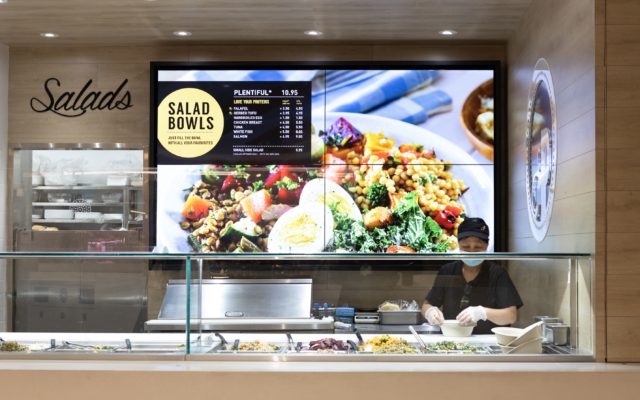When you step into public spaces, be it a restaurant or a shopping mall, it is impossible to avoid digital signage. Digital signage has become a staple in countless industries in today’s modern world, but it can be intimidating to those who are new to the technology. In this article we will be delving into the world of electronic signage and answering the important question: “How does digital signage work?”
What is Digital Signage?
Digital signage refers to an electronic display medium, typically in the form of digital screens, utilized to showcase a diverse array of multimedia content, including images and videos. While digital directories, menu boards, and promotional screens are among the most common applications, digital signage has swiftly become ubiquitous in the business landscape worldwide. In essence, it is omnipresent – evident in the advertisements encountered while waiting at bus stations, the screens adorning movie theaters, and even the displays providing gate information.
As digital signage increasingly integrates into our lives, both as business proprietors and consumers, comprehending its essence and significance is paramount. Recent statistics underline its pervasive reach, with an estimated 135 million people exposed to digital signage weekly. Moreover, there’s a surge in businesses embracing this technology, with a staggering 60% of enterprises without digital signage planning to invest in it within the next two years. In an era valuing efficiency and sustainability, the allure of digital signage lies in its convenience, environmental friendliness, and potential for time and cost savings.

What are the Components of Digital Signage?
In order to understand how electronic displays work, it is important to understand all of their components. Modern digital signage is typically comprised of three main components:
Digital Signage Hardware: The physical components of your electronic signage, which can vary depending on medium and also maker. While some styles of signage may utilize commercial grade screens, others may use digital kiosks, interactive touch screen signage, or specially designed screens as well. In order to facilitate a network connection, digital signage hardware also typically includes a media player to receive and play your content.
Digital Signage Software: This software is what enables the deployment, creation, editing, analysis, and scheduling of your content on your screens.
Digital Signage Content: The content deployed on your digital signage, which can include a combination of images, video, text, audio, and more.
How do Digital Signage Components Interact?
The three main components of digital signage interact and work with each other in order to provide you with the services you have come to rely on. When installing a new signage installation, you will typically start by installing the hardware, which includes screens, brackets, and media players. During this process, your provider will work with you to integrate your content into the signage software itself. Think of the digital signage software as the vehicle which allows you to display, change, and control your content.

Does Digital Signage Need a Wi-Fi Network?
Digital signage typically connects to your local Wi-Fi network, allowing for remote access 24/7 regardless of location. In areas without Wi-Fi however, the media player for your digital signage can act as its own local area access point; while this will not allow you to connect remotely, it will allow you to connect locally using any Wi-Fi capable device.
What are the Key Features of Digital Signage?
- Dynamic Content: Digital signage allows for the easy creation and display of dynamic content, which can include text, images, videos, and animations. This flexibility enables businesses to update and customize their messages quickly.
- Remote Management: Remote management is a service offered by digital signage providers which allows you to change, update, and schedule your content through an online portal.
- Interactivity: Some digital signage screens offer interactivity features, including touch screen capabilities that allow users to engage with their content. An example of this would be a mall or office building with touch screen wayfinding signage.
- Real-Time Information: Digital signage can display real-time information, such as news feeds, social media updates, weather forecasts, or live event schedules, providing relevant and timely content to your viewers.
- Cost-Effective Updates: Rather then printing new physical signage every time you need to make a change, digital signage allows you to make changes instantly and in a cost-effective manner.

Popular Facts about Digital Signage
The facts about digital signage speak for themselves and showcase the true use of this technology. For example, did you know that digital displays capture 400% more views than static displays? This is made even more impressive by the fact that digital signage has an recall rate of 83% – almost double that of traditional signage.
- 90% of the information transmitted to the brain is visual.
- 80% of customers choose to enter stores after seeing digital signage.
- 73% of diners agree that restaurant technology improves their guest experience.
- The human brain can identify images seen for as little as 13 milliseconds.
Related Posts

Sustainable Solutions: How Digital Signage Helps American Businesses Go Green
As sustainability becomes an increasing priority for modern American businesses, many business owners are looking for innovative ways to reduce their carbon footprint and adopt eco-friendly practices. Digital signage offers a compelling

Adapting Digital Signage for Seasonal Campaigns and Holiday Promotions
The holidays are fast approaching, which means many businesses are gearing up for their holiday marketing campaigns, promotions, and initiatives. There are many ways to use digital signage for holiday

5 Ways to Use Outdoor Digital Signage
Outdoor digital signage has become extremely popular in recent years and for a very good reason. This incredible technology has seen numerous advancements that allow it to be a staple

The Future of Outdoor Digital Signage: Weatherproof Displays and Sustainability
The future of outdoor digital signage is increasingly shaped by two key trends: the need for weatherproof displays and the drive toward sustainability. These trends are driven by technological advances,

